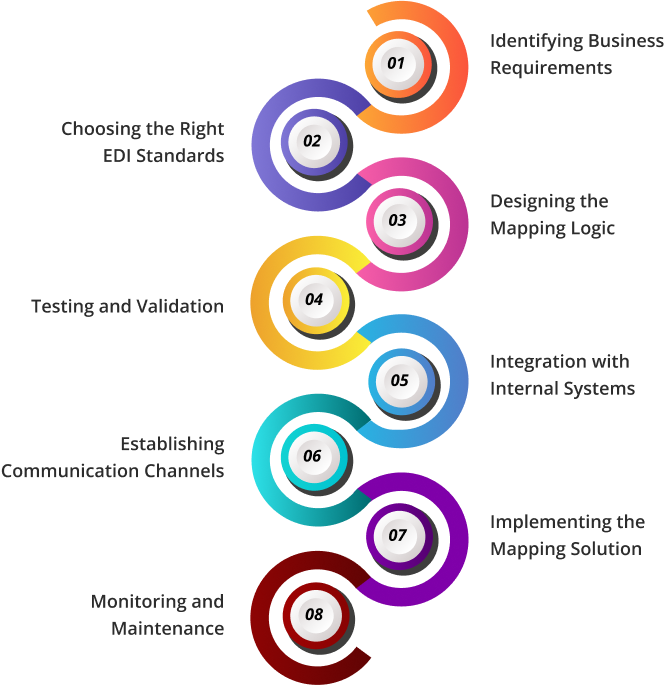
What is EDI Mapping?
EDI mapping is the process of converting business data into a standardized electronic format, enabling different systems to communicate seamlessly. It transforms documents like invoices and orders into formats that both parties can easily interpret, minimizing errors and speeding up workflows. By using the right tools and adhering to industry standards, businesses can streamline operations and collaborate more effectively with their partners.
How Does EDI Mapping Work?
EDI mapping works by translating data from one format to another, allowing different systems to communicate effectively. The process creates instructions that define how data in one format corresponds to another, allowing for automatic data conversion. The system supports various formats, including EDI, XML, and positional data. During the conversion, temporary encrypted files are created for security purposes. Additionally, data can be converted from formats like EDI into XML, ensuring smooth and efficient data exchange between systems, which accelerates business transactions and improves overall efficiency.
Benefits of EDI Mapping

Automation
EDI mapping automates the process of data transfer, reducing the need for manual intervention. For example, in the case of purchase orders, EDI mapping automatically converts and transmits orders from a buyer’s system to the suppliers, without any manual data entry. This reduces human error, speeds up the process, and eliminates the need for repetitive manual tasks.

Accuracy
EDI mapping ensures high levels of accuracy by eliminating human error. For instance, if a retailer sends an order to a supplier, the mapping ensures that all order details—like product codes, quantities, and prices—are correctly formatted and transmitted. This prevents mistakes such as incorrect product orders or pricing discrepancies, ensuring smooth business operations.

Connection
EDI mapping makes it easier for businesses to communicate with trading partners, even if they use different systems or formats. For example, a small manufacturer might not have the same EDI capabilities as a large retailer, but EDI mapping allows the manufacturer to send and receive data in a format that the retailer’s system can understand, without needing custom integrations.

Cost Saving Solution
By automating data exchanges, EDI mapping reduces operational costs. For instance, a logistics company can cut back on costs associated with printing and mailing invoices by sending them electronically via EDI. Additionally, by minimizing errors, businesses can avoid the costs of rework or correcting mistakes, such as reshipping an incorrect order.

Easier Communication
EDI mapping uses standardized formats, making communication between businesses easier and more efficient. For example, company shipping goods overseas can exchange customs documentation and shipping details in a universally recognized format, ensuring that all parties involved such as customs authorities, freight carriers, and suppliers understand the same information.

Faster Transactions
With EDI mapping, transactions are processed much more quickly than traditional methods. For example, when a customer places an order online, the EDI system can automatically process the order, send an invoice to the customer, and notify the warehouse for shipment significantly reducing processing time and improving the speed of the overall order-to-fulfilment process.

Data Security
EDI mapping ensures secure data exchanges, particularly important when dealing with sensitive information like financial data or customer details. For example, a bank transferring transaction details between branches will use encrypted EDI to ensure that the data cannot be intercepted or altered, protecting both the bank and its clients from fraud.

Enhanced Business Relationships
By improving the speed and accuracy of transactions, EDI mapping helps strengthen relationships between business partners. For instance, a supplier that consistently receives accurate orders on time from its clients is likely to build a stronger, more reliable relationship. As a result, the supplier is more likely to offer better terms and prioritize orders from that client, fostering long-term business success.

Scalability
As businesses expand, their data exchange needs grow as well. EDI mapping provides the scalability necessary to accommodate these changes without requiring significant overhauls to existing systems. For example, as a retail company expands its supplier base, EDI mapping can seamlessly accommodate the increased volume of transactions without needing to completely redesign the system. Whether the company is adding new partners or handling a larger number of transactions, the EDI system can grow with the business. This flexibility ensures that businesses can continue to thrive even as they scale operations or explore new opportunities.
These unique benefits help businesses boost operational efficiency, lower costs, improve communication, and strengthen relationships with partners, all of which contribute to sustained long-term success.
Challenges in EDI Mapping

Complexity in Mapping Different Formats
Once trained, the model is tested on new blueprints to ensure its generalization capabilities. Validation steps help fine-tune the model and improve its accuracy in extracting parts and materials lists from diverse sources.

Integration with Legacy Systems
Many businesses still operate using legacy systems that may not support modern EDI standards. Integrating these outdated systems with new EDI mapping solutions can pose significant challenges, requiring additional time, effort, and cost to ensure compatibility.

Data Quality and Consistency Issues
If the data entered into the system is inaccurate or inconsistent, it can lead to errors during the mapping process. Ensuring that data is clean, standardized, and consistent is critical for successful EDI mapping, as errors can lead to transaction failures or delays.
Steps for EDI Mapping

![]()
Identifying Business Requirements
To kick off the mapping process, businesses must first assess their needs. This includes identifying the types of documents to be exchanged, determining the required data formats, and clarifying the intended outcomes, all of which will guide the mapping approach.

Choosing the Right EDI Standards
Choosing the appropriate EDI standards (such as EDIFACT, X12, or others) is crucial. These standards define the structure and format of the documents exchanged, so selecting the correct one ensures compatibility between systems and smooth communication.

Designing the Mapping Logic
Mapping logic involves creating rules that define how data fields in the source document correspond to fields in the destination document. This is the core of the EDI mapping process, ensuring data is accurately transformed and transmitted.

Testing and Validation
Before implementing the EDI solution, businesses should conduct thorough testing to ensure the mapping logic works as expected. Validating the process helps identify and correct any issues before live transactions take place.

Integration with Internal Systems
EDI mapping must integrate seamlessly with internal systems, such as ERP (Enterprise Resource Planning) or accounting software. Ensuring this integration is smooth is vital for automating business workflows and achieving full operational efficiency.

Establishing Communication Channels
Once the mapping is complete, businesses need to establish secure communication channels for data transmission. These may include VPNs, FTP, or secure EDI networks to ensure safe and reliable exchange of data.

Implementing the Mapping Solution
After successful testing and integration, the EDI mapping solution can be deployed. This step involves rolling out the solution across the organization and ensuring that all stakeholders are trained to use it effectively.

Monitoring and Maintenance
Post-implementation, businesses should monitor the EDI mapping system to ensure it continues to operate correctly. Regular maintenance and updates are necessary to address any issues and keep the system aligned with evolving business needs.
Choosing the EDI Mapping Service
Assess Your Business Needs
Before selecting an EDI mapping service, it’s essential to evaluate your business needs. Consider the types of documents you need to exchange and your business requirements, such as compliance and scalability.
Evaluate Provider Expertise and Experience
Choose a provider with a proven track record in EDI mapping. Their expertise and experience will ensure they can deliver reliable, tailored solutions for your business.
Consider Integration Capabilities with Existing Systems
The EDI mapping service should easily integrate with your existing business systems, such as ERP or CRM. This ensures seamless automation and avoids disruptions in operations.
Check for Scalability and Future Growth Support
As your business grows, your EDI needs may evolve. Look for a provider that offers robust security measures, such as encryption and compliance with industry regulations like HIPAA or GDPR, to protect your sensitive business data.
Ensure Strong Security and Compliance Features
Security is critical when exchanging sensitive business data. Ensure the provider offers robust security features, including encryption, to protect your data during transmission. Also, check for compliance with industry regulations like HIPAA or GDPR.
Evaluate Pricing Models and ROI
EDI mapping services come with different pricing models. Evaluate the costs relative to the expected return on investment (ROI). Consider how much time and money the solution will save your business in the long run.
Look for Ongoing Support and Maintenance
A good EDI mapping service provider should offer continuous support and maintenance. This will help address any issues that arise and ensure that the system remains up-to-date and optimized.
Consider the Ease of Implementation
Finally, consider the ease of implementation. A solution that is easy to deploy and integrate with your existing systems will save time and reduce the potential for disruptions during setup.
Future-Proof Your Business with Advanced EDI Mapping Solutions
As businesses continue to evolve and adapt to new technological advancements, EDI mapping is also undergoing significant transformation. Here are some key trends and technologies shaping the future of EDI mapping:
- AI & Machine Learning: These technologies help improve accuracy and automate processes by learning from data, reducing errors and manual work.
- Cloud-Based EDI: Cloud solutions offer flexibility, scalability, and real-time processing, making it easier to manage and update EDI systems.
- Blockchain: Enhances security and transparency by tracking transactions on an immutable ledger, reducing fraud and ensuring data integrity.
- APIs: APIs allow seamless integration between EDI systems and other software, offering greater flexibility and collaboration with partners.
- Data Analytics: Real-time reporting and predictive analytics help businesses optimize their EDI processes and address issues before they occur.
Take the Next Step
Streamline your operations, enhance efficiency, and future-proof your business with cutting-edge EDI mapping solutions. Contact us today to learn more!









